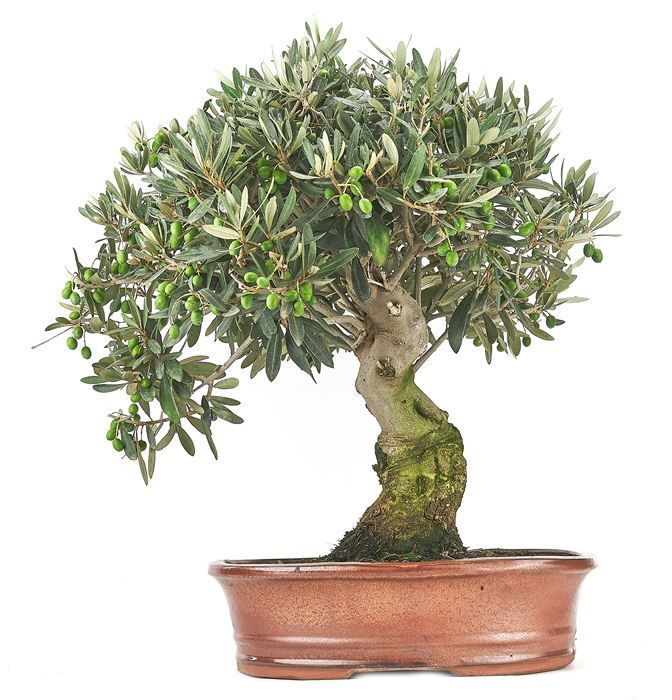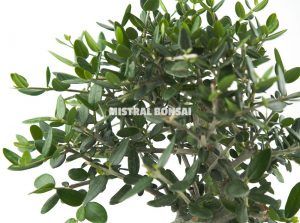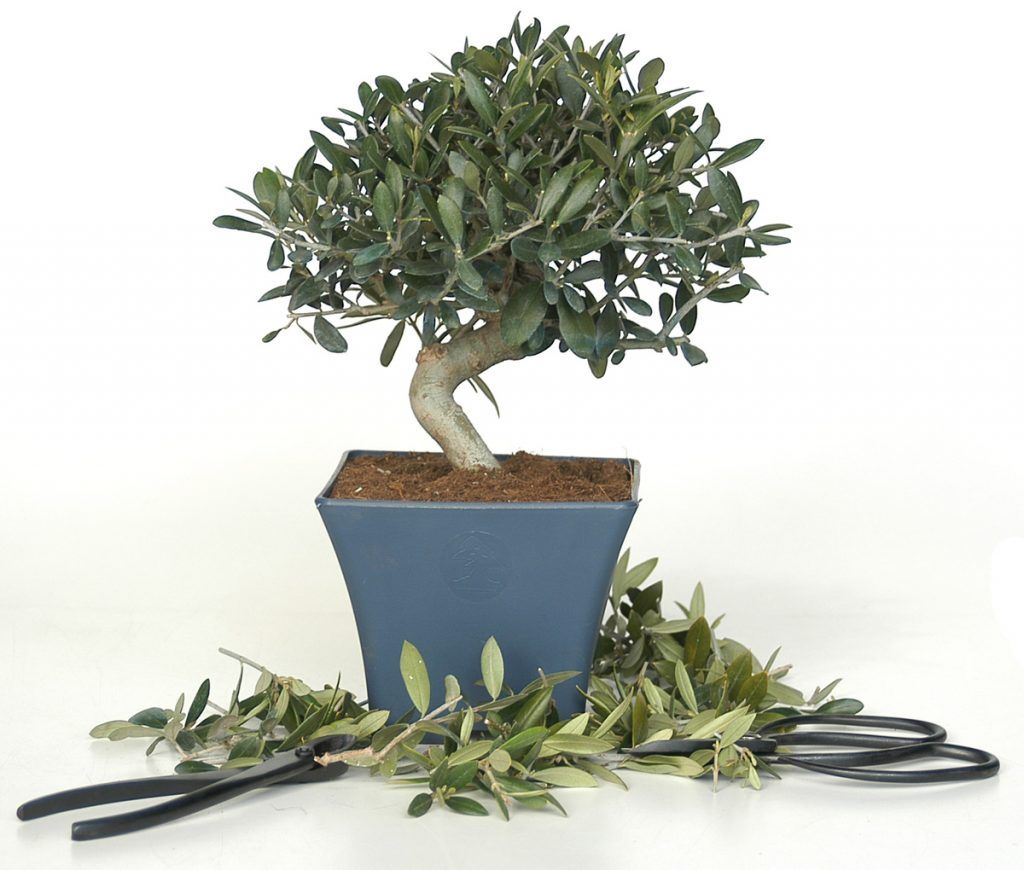Olive Bonsai Care Guide – The secret to take care of your olea bonsai step by step

Olive trees are wonderful bonsais! Both Olea europaea (Olive) and Olea europaea sylvestris (Wild olive), are spectacular trees to have in one’s bonsai collection. Do you want to know how to keep them healthy? Here we explain everything you cannot miss.
These trees belong to the Oleaceae family and originate from the Mediterranean coast. Their Latin name “Oleum” means oil, and the much appreciated olive oil is obtained from their fruits.
The olive bonsai tree, a tree with a lot of history
One of the great attractions of olive trees, that should not be forgotten, is that it is a tree steeped in history and symbolism.

Everyone recognises the white dove with the olive twig in its beak as an international symbol of peace. Also, in many cultures, it is given a meaning of wisdom, great age and longevity. These are trees that usually live for many years and resist adverse conditions, still regreening afterwards. Not surprisingly, it is also associated with resistance and renewal, even being considered a sacred tree.
For the ancient Hebrews, olive oil was a symbol of Divine Blessing; For this reason, they anointed their kings with this oil.
For Christians, the Olive Tree is an emblematic tree, since Jesus used to meet and pray with his disciples in “The Mount of Olives”.
For Muslims, the Olive Tree and its oil are allegorically related to the Light of God that guides human beings.
And not only the tree is the object of symbolism. Olive oil has been given medicinal properties, using it as a symbol of healing.
Main differences between olive bonsai and wild olive bonsai trees
The olea europea is known as olive tree or olive. One of its varieties is sylvestris, which is commonly called wild olive. The common olive tree has been gaining popularity in recent centuries due to its level of olive oil production. But in recent years, wild olive has generated growing interest for its resistance to drought and for its wood.
 |
 |
|
|
|
|
 |
 |
|
|
|
|
|
|
|
|
Where to locate them?
These trees are Mediterranean, therefore, they love sun in abundance. If you live in a zone with a Mediterranean climate, you should place it outside in full sun all year round. Outside its natural climate, it is advisable to protect it from extreme cold, especially from frost (temperatures below zero for more than 24 hours). Despite this, the olive tree needs low temperatures in winter as long as it does not drop below 5º degrees, since frost can destroy its root system and its phloem’s constitutive vessels.
When can you wire them?
It can be wired throughout the year, keeping in mind that, when there is more sap circulation (spring), the branches are more malleable.
When to prune my olive bonsai?
We recommend pruning in early March (before spring begins); in this way, you will eliminate those unnecessary branches. With spring will also come the growing period. The tree will use its energy to develop the shoots necessary to achieve a better design.
How should I pinch it?
Pinching can be done between April and October. When the shoots are long (till 7 or 8 pairs of leaves). You can pinch leaving between 2 and 3 pairs of leaves.
How often can I repot my olive trees?
Olive trees are very slow growing trees. Achieving an abundant root mass can really take time. Due to their slow growth, these bonsais can be re-potted every 3 or 4 years.
What type of substrate can I use?
We recommend Terrabonsai; A substrate specially developed by Mistral Bonsai’s technicians. It helps keep your tree healthy, with the necessary moisture retention and the proper drainage for its development. If you already have experience with olive trees and master the watering technique, you can use 70% Akadama and 30% Pomice as an alternative. It develops a better root system faster, although it requires higher watering control.
Watering olive bonsais
Watering should be moderate in spring, abundant in summer, and scarce in autumn and winter. Remember that there is no standard number of times to water a week. Apply the watering technique correctly and you will supply water at the necessary frequency according to the season and to the needs of your tree.
How often should I fertilise my olive trees?
Like for most of our bonsais, we have to fertilise them from March to October. We should start before spring and continue fertilising in summer, until temperatures rise up to 35 Cº. Within this period we can fertilise with a fertiliser that contains more nitrogen than phosphorous and potassium. These fertilisers are called growth fertilisers. For example a fertiliser that is N6, K4, P4 is a fertiliser that has more nitrogen molecules (6) and has the same level of potassium as of phosphorus (4); it is an example of growth fertiliser. Then when the temperature exceeds 35 ºC in summer, we stop the fertilisation. Once the summer temperatures drop below 35 ºC, we start fertilising again, until the end of autumn. During this period we can fertilise combining fertilisers that are rich in phosphorus and potassium, these are accumulation fertilisers. For example, a N4, K6, P4 or a N3, K5, P5 would be an appropriate fertiliser.
What bonsai style best suits my olive tree?
This is a very versatile tree, that can be shaped into the main bonsai styles, from the main five (Chokkan, Moyogi, Sakan, Kengai and hang-kengai) up to the so-called secondary styles such as fukinagashi, ishizuki, Bunjin, Sokan, Seki-joju and Sharimiki.

As you can see, olive trees are very easy to care, very durable and resistant. They can be formed within many styles, making them an ideal choice for bonsai. Go ahead and add to your bonsai collection this wonderful millenary and mystical species!
About the Author
Mistral Bonsai
In Mistral Bonsai we are a communication team, technicians and masters committed from the first day to disseminating the wonderful art of bonsai. A world that offers many things to share. We believe that a bonsai is a tree with a soul, unique and unrepeatable. Another of our most essential pillars is, how could it be otherwise, our close commitment to the preservation of the environment and nature.
Categories
Bonsai cultivation and care (60)
Bonsai gift (2)
Bonsai pests and diseases (7)
Bonsai repotting (3)
Bonsai species (1)
bonsai substrates (2)
Bonsai summer (1)
bonsai tools (1)
Bonsai work (13)
Ceramic pots (3)
Chinese culture (1)
Chinese culture (2)
Coniferous bonsai (2)
Conifers (1)

